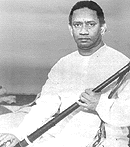Nadaswara Chakravarti Rajaratnam Pillai
Dr. K. Rohiniprasad

Like its North Indian counterpart the shehnai, nadaswaram is an ancient musical instrument closely associated with temples and auspicious social occasions like weddings. The strident notes of nadaswaram beckon people from afar and invite them to the location of the festivities. Generally played in the open air, the nadaswaram tradition is so ancient that specific ragas and compositions would be played at specific times in the temples. Besides worship inside temples during service, special processions of the deities are taken out on the streets, always accompanied by nadaswaram music. Nadaswaram has also become a concert instrument in Carnatic music with immense following. In fact several eminent vocalists have been inspired by nadaswaram music. There have been several great players of this wind instrument in the South, one of the best among them being Rajaratnam Pillai.
Born in 1898 in Tanjavur district, Rajaratnam belonged to a great tradition of famous nadaswara vidwans. As a youngster, he started singing very well. He underwent rigorous training in nadaswaram from his uncle Thirumarugal Natesa Pillai, the well-known nadaswaram artist. He was later taught by the violinist Thirukodikaval Krishna Iyer, Ponnu Pillai, Konerirajapuram Vaidynatha Iyer and Manpoondia Pillai. His association with the great percussionist Needamangalam Meenakshisundaram Pillai helped to improve his stature as a musician.
Rajaratnam Pillai’s name and fame spread far and wide very quickly in spite of the presence of other very eminent nadaswaram vidwans such as Semponnarkovil brothers, Keeranur brothers, Tiruveezhimizhalai brothers, Tiruvengadu Subramanya Pillai, Kuzhikkarai Picchayappa, Tiruvidaimarudur Veeruswamy Pillai, Tirumarugal Natesan and Madurai Ponnusway. Rajaratnam Pillai’s elaboration and embellishment of ragas, flawless rendition of the works of great composers and his perfect grasp and control over tala were unparalleled.
Ragas like Todi, Simhendramadhyamam, Shanmukhapriya, Ramapriya, Vachaspati, Pantuvarali and Kalyani as rendered by Rajaratnam Pillai on his a medium-sized instrument with a pleasant timbre regaled countless fans of his. His short gamaka-laden phrases, twists, swooping glides and lightning speed techniques made Todi his speciality and an all-time favourite. It was a divine experience to listen to him playing ragas such as Saveri, Bilahari, Dhanyasi, Sri and Natakuranji. The attractive timbre in the tone of his instrument was an added advantage. With limitless imagination, he became a source of inspiration not only to nadaswara vidwans but to musicians in general. His music was rich with creativity and he was always bursting with new ideas.
His fresh and invigorating music was the main attraction in the three hour-long procession of the decorated car festival of Saibaba in
Rajaratnam Pillai’s larger-than-life image as a musician elevated nadaswaram from temple processions and to the concert platforms. His eminence as a performer in
Rajaratnam Pillai is supposed to have led a very adventurous life. He was an admirer and friend of S.G. Kittappa, the famous stage singer and personality. He also praised M.S. Subbulakshmi’s singing. After climbing to fame and fortune, Rajaratnam Pillai’s vices reportedly caused his fall from grace and early demise in 1955. With his departure it was felt that the sun had set on the nadaswaram music. There have been several generations of eminent nadaswaram players but Rajaratnam occupies a unique place among them.


1 Comments:
good article to read and know about TNR
Post a Comment
<< Home